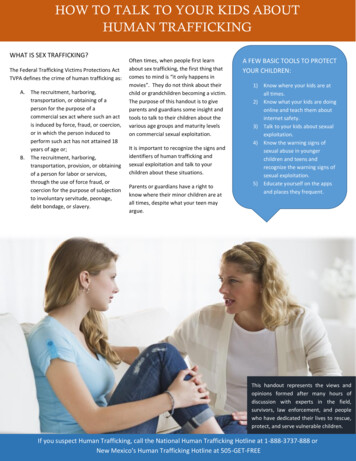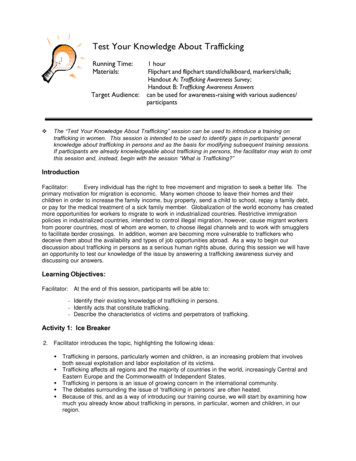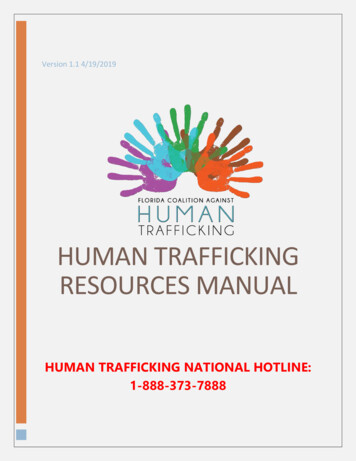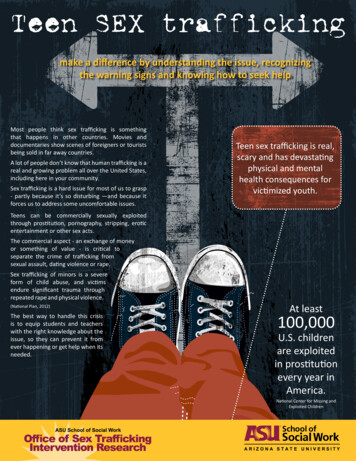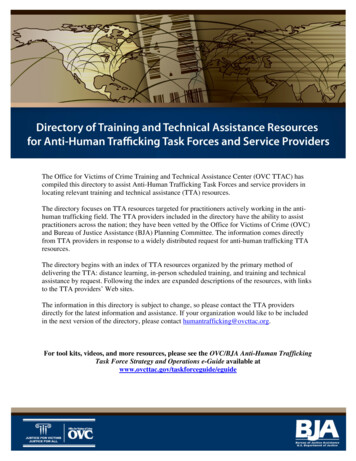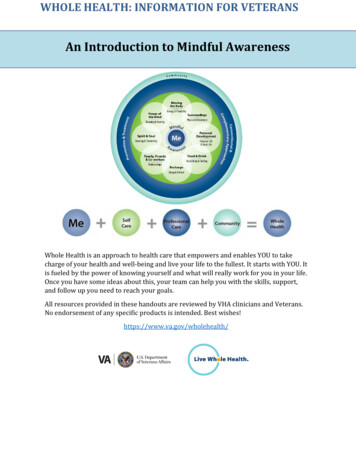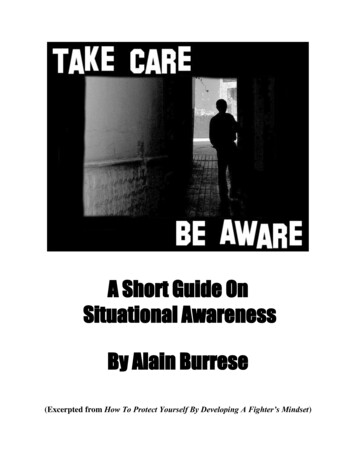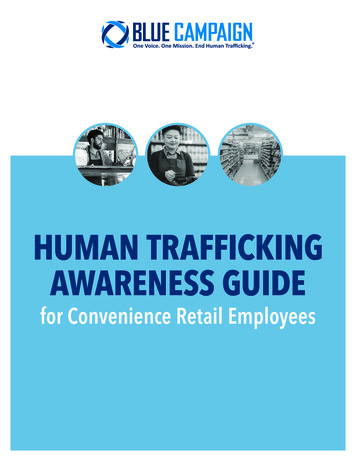
Transcription
HUMAN TRAFFICKINGAWARENESS GUIDEfor Convenience Retail Employees
ABOUT THIS GUIDEConvenience retailers can play a significant role in combating human trafficking because of their presencein virtually every community - urban, suburban, and rural - as well as their often 24/7 operations. There arethousands of convenience stores across the country where employees are interacting with customers all day, fromregulars to travelers passing through. Because convenience retail employees observe and communicate with thepublic so frequently, they are in a unique position to observe indicators of human trafficking while working.The purpose of this guide is to inform front line convenience retail employees about human trafficking and theindicators that may help them recognize a potential victim while on the job.CONVENIENCE STORES’ ROLE IN COMBATINGHUMAN TRAFFICKINGTraffickers and victims may utilize convenience stores to purchase food and other goods, gas, or to use therestroom. Traffickers may take advantage of the expediency, anonymity, and low-cost items that conveniencestores offer. If convenience retail employees learn how to recognize and report suspected human trafficking, theymay be able to help victims leave their trafficking situation and keep traffickers from harming more people.WHAT IS HUMAN TRAFFICKING?Human trafficking involves the use of force, fraud, or coercion to obtain some type oflabor or commercial sex act. Causing someone under the age of 18 to engage in a commercialsex act, regardless of using force, fraud, or coercion is human trafficking under U.S. law.1 Humantraffickers use various forms of force, fraud, and coercion to control and exploit victims. Theseforms include imposing of debt, fraudulent employment opportunities, false promises of love or abetter life, psychological coercion, and violence or threats of violence.2The crime of human trafficking hinges on the exploitation of another person. Peopleoften falsely believe “human trafficking” implies victims must be moved from one place toanother to qualify as a victim. Human trafficking does not require transportation to be considereda crime.3 It is a crime that can be committed against an individual who has never left their hometown.Who Are Victims?Human trafficking victims can be any age, race, gender identity, sex, ethnicity, nationality,immigration status, and socioeconomic class. In many cases, victims do not come forward to seek helpbecause they are vulnerable, potential language barriers may exist, they have a fear of law enforcement, or theydo not identify as a victim.123See 18 U.S.C Chapter 77 for precise definitionsSee 18 U.S.C Chapter 77 for language on elements of the crimeLearn more about the difference between human trafficking and human smuggling: dhs.gov/bluecampaign
INDICATORS OF HUMAN TRAFFICKINGDuring the workday you observe customers as they shop and communicate with them during check-out. Whilecustomers are in and around your retail location, you may be able to observe physical and behavioral indicators ofhuman trafficking.No single indicator is proof that human trafficking is occurring. The indicators below are a few examples that mayalert you to a potential human trafficking situation:AppearanceThe potential victim(s):» Shows signs of fear, anxiety, tension, submission, and/or nervousness.» Shows signs of physical abuse, restraint, and/or confinement.» Exhibits evidence of verbal threats, emotional abuse, and/or being treated in ademeaning way.» Shows signs of malnourishment, poor hygiene, fatigue, sleep deprivation, untreatedillness, injuries, and/or unusual behavior.» Dresses inappropriately for their age or have lower quality clothing compared to othersin their group.» Dresses inappropriately for the weather.» Appears to be with a significantly older “boyfriend,” “girlfriend,” or romantic partner.» Is in a group of varying ages or ethnicities and don’t seem to have a social dynamic.» Is in a group where everyone has identical tattoos in similar locations. This may indicate“branding” by a trafficker.ActionsThe potential victim(s):» Lacks freedom of movement or is constantly monitored by someone.» Avoids eye contact and interaction with others.» May be purchasing condoms, lubrication, pregnancy tests.» May be making multiple purchases throughout the day.» Has no control over or possession of money or ID.» Defers to someone else to talk for them or appear to be coached on what to say.» May not be able to provide logical details about their travel plans, if asked.
SCENARIOS: WHAT HUMAN TRAFFICKING MAY LOOKLIKE IN CONVENIENCE STORESThe following examples are fictional but based on actual indicators that someone is a potential victim ofhuman trafficking.Regulars Can Be TraffickersJoel has been running his neighborhood’s convenience store for the past decade. It islocated in a busy neighborhood of a bustling city, so on a normal day he interacts withhundreds of customers. Despite seeing so many customers every day, Joel still has regularswho live in the neighborhood and surrounding areas. One of his regulars is a man that goesby “Ghost.” Ghost is in his 30s and is always friendly to Joel and his staff. When Ghostcomes by, he usually buys something to drink and then hangs outside the store with someother locals for an hour or so. Ghost is typically by himself or with a friend when he comesinto the convenience store but one day he brings in two girls who look very young andJoel has never seen before. Joel sees a lot of teenagers during a typical workday, but theyare usually energetic and social with one another. The girls with Ghost appear to be verysubmissive and quiet, and dressed in revealing clothes not appropriate for the cold weather.Ghost tells the girls they can each pick out two items but that they should “choose wisely,because that’s your dinner.” The girls don’t seem to be carrying their own money and whenthey’re ready to check out, they defer to Ghost to pay for their items. Joel knows somethingis off, but he also knows and likes Ghost and decides not to take action. Over the next threeweeks, Ghost continues to bring in different young girls to buy food, and they always have a quiet and submissivedemeanor and don’t look or speak to Joel when he tries to talk to them. Joel decides to report what he’s seeing,especially because the girls may be minors.Routine Rest Stop or Something More?Ashley works the evening shift at a convenience store attached to a gas station in a smallrural town by the interstate. Her shifts are usually pretty slow, so she is able to observe allthe customers who stop off to purchase items, use the bathroom, or pump gas. Duringone of her shifts, she notices a utility van pull up and a large group of men and women ofvarying ages and ethnicities get out. She is used to seeing groups of seasonal workers inthe area, but this group looks particularly disheveled and distressed. She can see there aretwo adults in the group that seem to be in charge of the others because they are yelling atand even pushing some people as they get out of the van. As the group enters the store,everyone lines up to use the restroom. As they walk by, she notices their clothes are in poorcondition, they have little personal belongings with them, and some of them even haveuntreated injuries. The group leaders approach the counter to purchase a few snacks andpacks of cigarettes for themselves. Ashley knows something is off, so she takes note ofthe name and city on the ID she checks for the tobacco purchase. As everyone returns tothe car, she writes down the information along with the van’s license plate. She is not sureexactly what she just saw but knows she needs to report it.
REPORTING HUMAN TRAFFICKINGWhat to ReportIf you observe suspected human trafficking, the details you provide in your tip can be crucial to locating thetrafficker and victim(s). Be observant and try to collect as much information as possible about the situation andpeople, like:» Approximate ages and the number of individuals involved» Details about their physical appearances (hair and eye color, ethnicity, prominent facial features, tattoos, etc.)» Travel details (where they are going or coming from)» Details about their name, address, etc. if ID was checked for a purchase» Nicknames or gang-related affiliations being used» Vehicle information (color, make, model, license plate, etc.)How to ReportDo not attempt to confront a suspected trafficker directly or alert a victim to your suspicions. Your safetyas well as the victim’s safety is extremely important. Instead, please follow one of the reporting options below:» Follow your company’s protocol for reporting suspicious activity or crime taking place at your location.» Call the Homeland Security Investigations (HSI) Tip Line at 1-866-347-2423 to report suspiciouscriminal activity, including human trafficking, to federal law enforcement 24 hours a day, 7 days a week. Youcan also submit an anonymous tip online via the HSI Tip Form at: ice.gov/webform/hsi-tip-form.» Call the National Human Trafficking Hotline at 1-888-373-7888 to report suspected human trafficking.It is toll-free and available to answer calls from anywhere in the country, 24 hours a day, 7 days a week, inEnglish, Spanish, and more than 200 other languages. It is not a law enforcement or immigration authority andis operated by a nongovernmental organization.» Call 911 or local authorities if someone is in immediate danger.ABOUT BLUE CAMPAIGNBlue Campaign is a national public awareness campaign, designed to educate the public, lawenforcement and other partners to both recognize the indicators4 of human trafficking, and respondappropriately to possible cases. Blue Campaign works closely with DHS Components to creategeneral awareness training5 and materials for law enforcement and others to increase detection ofhuman trafficking, and to identify victims.Information on additional resources and training offered by Blue Campaign can be found atdhs.gov/bluecampaignContact Blue n@dhsbluecampaign4 Learn more about the indicators of human trafficking: 5 Find more training resources: dhs.gov/blue-campaign/awareness-training
RECOGNIZE AND REPORT HUMAN TRAFFICKINGPost this info sheet behind the counter or in a place where employees can quickly reference it.Every day convenience stores conduct millions of transactions with customers across the country. Mostcustomers are coming in for a quick purchase, but some may need help and can’t ask for it. Victims of humantrafficking are often afraid to ask for help due to fear of their trafficker. While on the job, you may be able torecognize and report suspected incidents of human trafficking, which could help save someone’s life.INDICATORSNo single indicator is proof that human trafficking is occurring. The indicators below are a few examples thatmay alert you to a potential human trafficking situation:AppearanceThe potential victim(s):» Shows signs of fear, anxiety, tension, submission, and/or nervousness.» Shows signs of physical abuse, restraint, and/or confinement.» Exhibits evidence of verbal threats, emotional abuse, and/or being treated in a demeaning way.» Shows signs of malnourishment, poor hygiene, fatigue, sleep deprivation, untreated illness,injuries, and/or unusual behavior.» Appears to be with a significantly older “boyfriend,” “girlfriend,” or romantic partner.ActionsThe potential victim(s):» Lacks freedom of movement or is constantly monitored by someone.» Avoids eye contact and interaction with others.» Has no control over or possession of money or ID.» Defers to someone else to talk for them or appear to be coached on what to say.HOW TO REPORTDo not attempt to confront a suspected trafficker directly or alert a victim to your suspicions. Your safetyas well as the victim’s safety is extremely important. Instead, please follow one of the reporting options below:» Follow your company’s protocol for reporting suspicious activity or crime taking place at your location.» Call the Homeland Security Investigations (HSI) Tip Line at 1-866-347-2423 to report suspicious criminalactivity, including human trafficking, to federal law enforcement 24 hours a day, 7 days a week. You can alsosubmit an anonymous tip online via the HSI Tip Form at: ice.gov/webform/hsi-tip-form.» Call the National Human Trafficking Hotline at 1-888-373-7888 to report suspected human trafficking.It is toll-free and available to answer calls from anywhere in the country, 24 hours a day, 7 days a week, inEnglish, Spanish, and more than 200 other languages. It is not a law enforcement or immigration authorityand is operated by a nongovernmental organization.» Call 911 or local authorities if someone is in immediate danger.
labor or commercial sex act. Causing someone under the age of 18 to engage in a commercial sex act, regardless of using force, fraud, or coercion is human trafficking under U.S. law. 1. H
